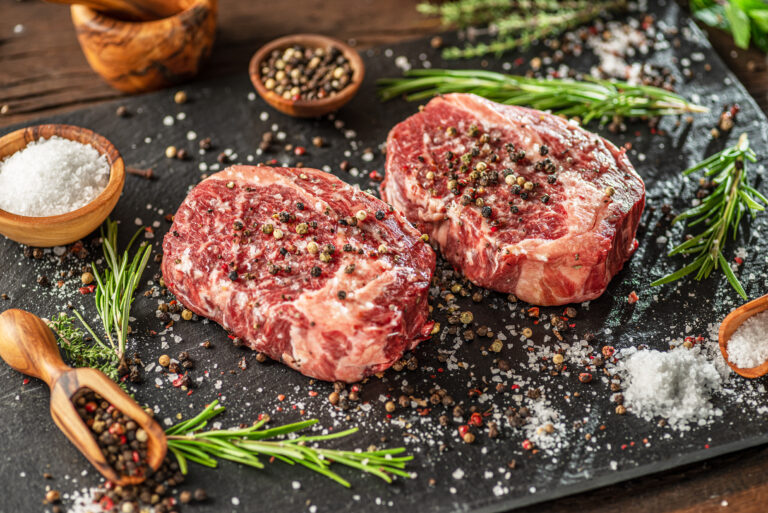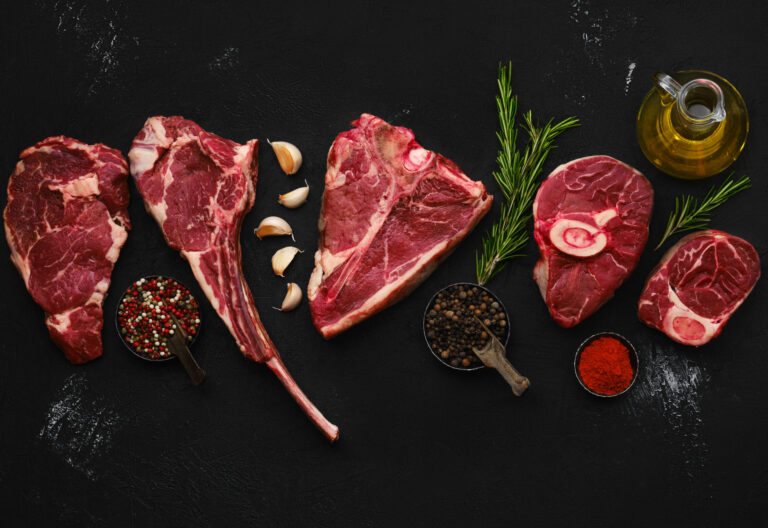5 Differences Between Flat Iron vs Flank Steak to Make the Best Choice
Flat iron and flank steak are popular cuts of beef, each with unique pros and cons. Flat iron is tender, well-marbled, and rich in flavor, while flank steak is leaner and stronger in beefy taste. The choice between the two depends on your recipe and desired outcome.

We will review flat iron vs. flank steak and compare the pros and cons of each type of steak, so you can make an informed decision about which to cook.
Being a restaurant owner, I want to serve the best meat to my customers. And for that, I had to do my research and speak to specialists so that I know what I’m buying.
When we cook at home, we also want to eat flavorful meat and feel satisfied at the end of the meal. And that’s why I want to share what I’ve learned with you. Keep reading to find out all the information you need about these two cuts and see which one is best for each situation.

Disclosure: As an Amazon Associate, this site earns from qualifying purchases. Thank you!
What Is Flat Iron Steak?
The flat iron steak comes from a cow’s shoulder and is known for its tenderness and rich flavor. It is a less expensive cut of beef compared to other popular cuts, such as ribeye or filet mignon.

Nutritional Value and Serving Size
A general serving size for flat iron steak is 3 oz (85g) per person.
A flat iron steak contains around 189 calories and 21 grams of protein. In a 3oz serving, it contains 11 grams of fat.
Other Names
Other names include top-blade steak, butler steak, and oyster steak.
Top blade steak” comes from the steak cut from the top blade roast, also known as the shoulder tender, which is a muscle located near the shoulder blade. It is a small, tender muscle often used as a roast but can also be cut into steaks.
“Butler steak” is also a nickname for this cut as it is said to have a similar texture to filet mignon, which is often referred to as “the butcher’s cut” or “the butler’s cut”.
“Oyster steak” is another name for the flat iron steak due to its shape and texture resembling an oyster.
Where Does Flat Iron Steak Come From?
The flat iron steak is a cut from the top blade roast located in the cow’s shoulder area. The muscle is heavily used, making it a leaner cut of meat with a rich flavor.
It is also leaner than other cuts and is usually cut into smaller portions.
How to Prepare and Cook Flat Iron Steak
Turn the oven temperature up to 200 degrees, brush them with oil and then season the steaks with salt and pepper.
Once placed in the oven, you should cook steaks to an internal temperature of 115F to 120F for medium rare. Cooking time will vary from 20 to 40 minutes, based on the thickness of the steak.
Then melt two tablespoons of butter in a cast-iron pan over medium heat. Sear the steaks for 1-3 minutes on each side in a hot pan, basting with butter as needed, until the meat is cooked through and a deep golden brown. Take the steaks away from the fire and let them sit for ten minutes.
What Is Flank Steak?
Flank steak is usually a leaner cut of meat that comes from the abdominal area of the cow, just below the loin. It is flavorful but can be tougher than other cuts. It is typically sliced thin against the grain before serving.
Nutritional Value and Serving Size
A general serving size for flank steak is 3 oz (85g) per person.
Flank steak contains around 163 calories and 24 grams of protein. It contains 7 grams of fat per 3 oz serving.
Other Names
Other names include London broil, jiffy steak, and bavette steak.
“London broil” is a name that refers to a cooking method rather than a cut of meat. It typically referred to a thicker cut of beef, often top round or flank, that was marinated and cooked quickly at high heat.
“Jiffy steak” is a term that describes a quick and easy way to prepare and cook flank steak.
“Bavette steak” is a name used to refer to flank steak in French cuisine. It is a traditional French cut of beef that is similar in flavor and texture to flank steak.
Where Does Flank Steak Come From?

Flank steak is a beef cut from the cow’s abdominal muscles. It is a lean cut of meat known for its bold, beefy flavor. Flank steak is also relatively inexpensive and easy to find in most grocery stores.
How to Prepare and Cook Flank Steak
Because of its tender, thin texture, flank steak requires less cooking time, whether roasted or grilled.
Put the grill or pan over medium heat to start. Sprinkle coarse sea salt on the flank steak and throw it on the grill as soon as it can handle the heat.
Prepare it by frying it for approximately a minute on each side to achieve deep roasting marks. The flank steak should be cooked to an internal temperature of around 145 degrees, either on a passive heat zone of the grill or in an oven preheated to 260 degrees.
During the final part of resting, the meat’s internal temperature rises by 5 degrees.
Flat Iron vs. Flank Steak
Flat iron steak and flank steak are both popular cuts of beef known for their beefy flavor and versatility in cooking. However, some key differences between the two cuts should be considered when deciding which one to use in a recipe.
Flat Iron Steak Pros
- A tender cut of meat
- Rich beefy flavor
- Well-marbled and fattier than other cuts
- Reminiscent of fillet but less expensive
Flank Steak Pros
- A lean cut of meat, lower in fat and calories
- No bones
- Stronger beefy flavor
- Reminiscent of skirt steak
Flat Iron Steak Cons
- More fat content
- May have bone-in
- It can be smaller than other cuts of steak
- You can overcook it quickly
Flank Steak Cons
- It can be chewy and tough if not cooked properly
- It can be difficult to slice against the grain
- Not as rich tasting
- It needs to be cooked slowly at a low temperature
Which Is Better: Flat Iron vs. Flank Steak?
Flat iron and flank steak are delicious and versatile cuts of beef that you can use in various dishes. Whether one is better depends on the recipe and desired outcome.
Flat iron steak is usually a more tender cut of meat and is great for grilling, broiling, and pan-searing. It can be a great option if you’re looking for a tender and juicy steak to serve as a main course. It is also a good option to slice the steak and use it in sandwiches or salads.
Flank steak is often a leaner cut of meat and is great for grilling, broiling, and stir-frying. It is a good option if you’re looking for a leaner cut of meat that is still flavorful. It is also a good option for dishes that require thinly sliced meat, such as fajitas or stir-fry.
Both cuts of meat are tasty and useful, but the one you choose will depend on the recipe, the result you want, and your personal taste.
What is a flat iron steak best used for?
A flat iron steak is a relatively versatile cut of beef that you can use in various dishes. It is best suited for dishes that require a tender piece of meat, such as grilled steaks, stir-fries, and sandwiches. Flat iron steak can also be a great cut of beef for marinating, as its tenderness allows it to absorb flavors easily.
Is flat iron or skirt steak better?
Both flat iron and skirt steak are similar cuts of beef known for their tenderness and rich flavor. However, flat iron steak is considered to be slightly more tender than skirt steak. Skirt steak is also a bit leaner than flat iron steak. Ultimately, choosing a flat iron and skirt steak will depend on your preference and the specific dish you are preparing.
Which steak is easier to cook?
Both flat iron and flank steak are relatively easy to cook, but they may be slightly more tender and easier to work with due to their smaller size.
Which is more tender?
Flat iron steak is generally considered more tender than flank steak, but it can be made more tender by slicing against the grain and not overcooking it.
Which of the two steaks is larger?
Flank steak is generally larger than flat iron steak, as it comes from a larger muscle in the cow.
Which steak is more economical?
Flat iron steak is generally considered more economical than flank steak as it is less expensive per pound than flank steak. However, the price may vary depending on location and the specific cut of meat.
More FAQs
Can I use flat iron steak instead of flank?
You can use flat iron steak as a substitute for flank steak. Both cuts require a good marinade and are best when cooked to medium-rare and sliced against the grain. If you are unable to find flat iron steak, which may be more difficult to locate, flank steak is a suitable alternative.
What is the closest substitute for flank steak?
The closest substitute for flank steak is skirt steak, flat iron steak, flap (sirloin tip) steak, tri-tip steak, and hanger steak (in that order).
What is flank steak called at the grocery store?
Flank steak is commonly referred to as London Broil at the grocery store. This name can often be seen on packaging or menus. It is important to note that top round is also sometimes labeled as “London Broil,” so it is necessary to be familiar with the appearance of the cut to ensure you are purchasing the correct one.
What is another name for flank steak?
The other name for flank steak is London Broil, Plank Steak, Jiffy Steak, Bavette in French, and Arrachera in Spanish. Flank steak is derived from the underbelly, or flank, of the cow, and it is occasionally used interchangeably with skirt steak, although they are distinct cuts (although their textures are comparable).
Does flank steak get tough?
Flank steak can become tough if not properly cooked. It is important to monitor the cooking process to avoid burning or overcooking, which can result in even tougher and potentially inedible meat.
Is flat iron steak very tender?
The flat iron steak is indeed very tender, as it originates from the second most tender muscle in the body, with the first being the Tenderloin (or Filet Mignon). This innovative and affordable cut offers intense beef flavor, exceptional tenderness, and a high level of marbling.
What’s the most tender steak?
The most tender steak is the tenderloin steak, which is renowned for its lean composition, delicate texture resembling butter, and substantial thickness. These delectable steaks are so tender that they can be effortlessly sliced with a butter knife. Additionally, tenderloin steaks are commonly referred to as filets or filet mignon.






